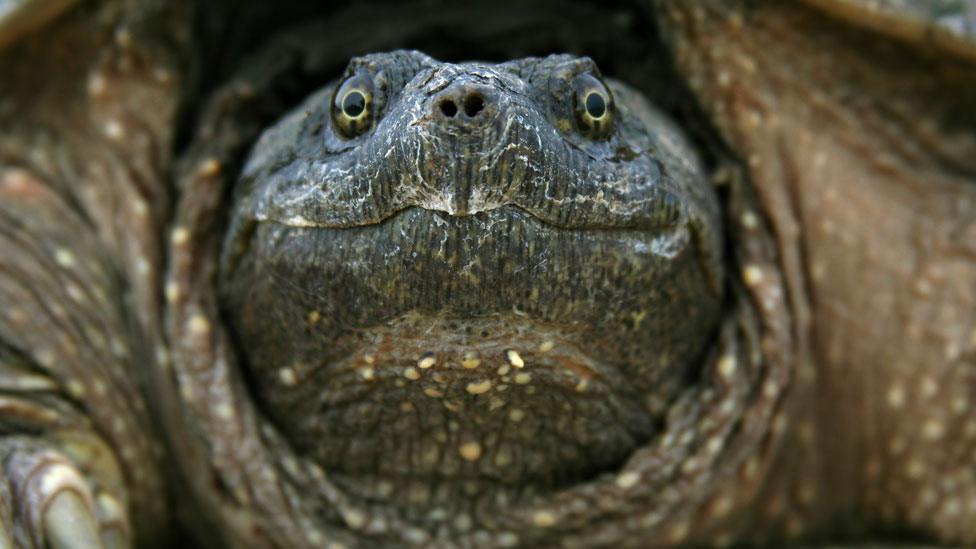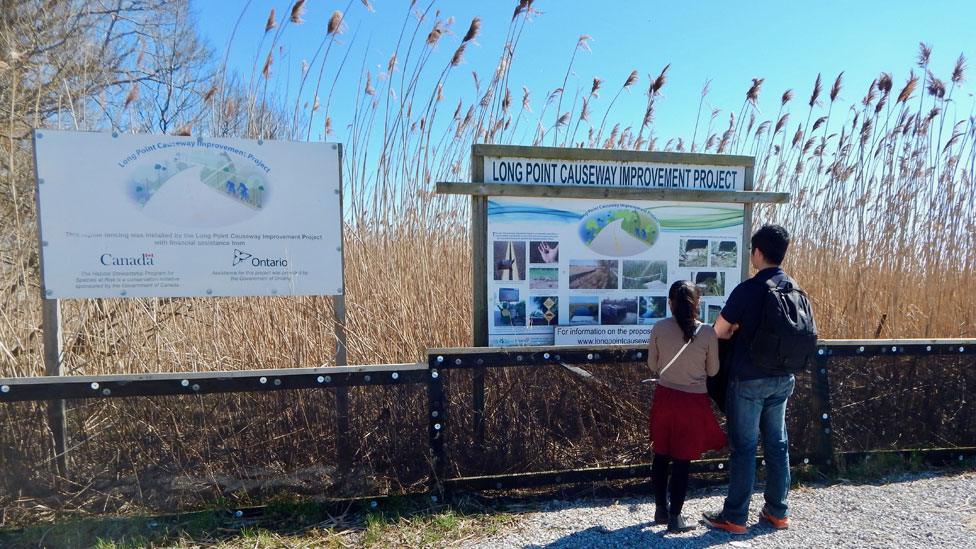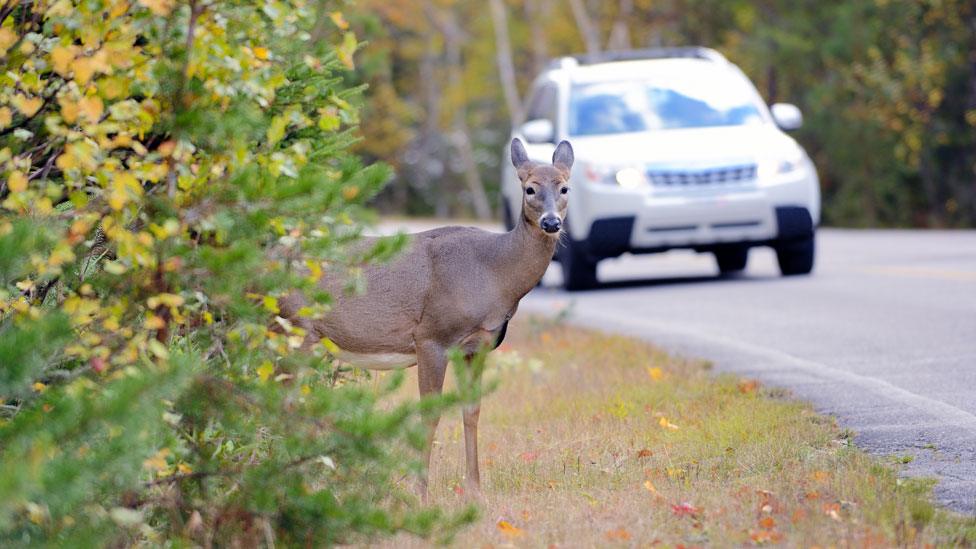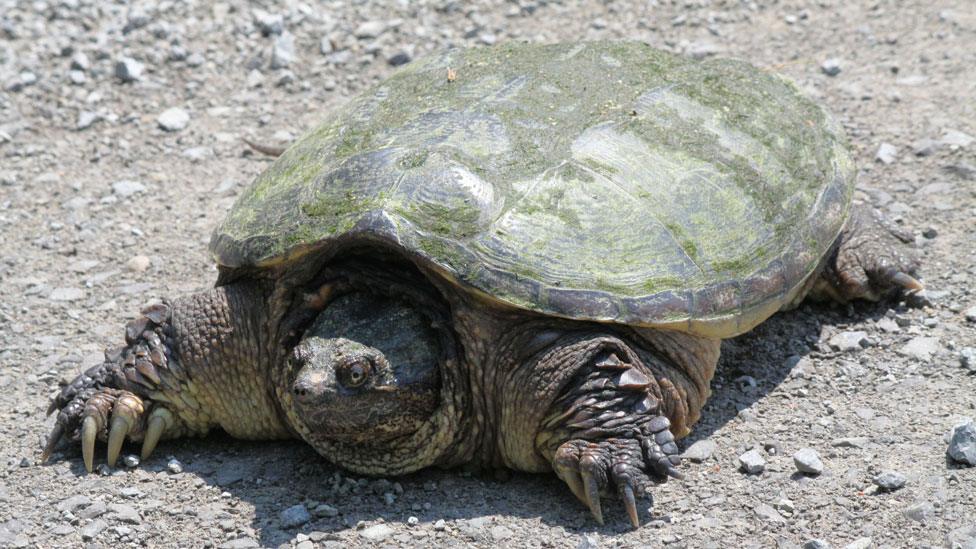Turtle disaster avoided with roadkill rescue
- Published

Snapping turtles were among those caught up in the roadkill "slaughter"
For anyone on a long drive on a country road, one of the bleakest sights is the amount of roadkill you see punctuating the passing miles.
It shows the fatal incompatibility between our need to get to places quickly and wildlife trying to get across a road.
In terms of the odds being stacked up against an animal, it's particularly bad news for the slow-moving turtle. They're not exactly going to sprint away from danger.
But research published by academics at McMaster University in Ontario, Canada, reports on the major success of a scheme to reduce roadkill.
The findings are claimed to provide lessons for the global problem of animal deaths on roads.
Worst roadkill
The project focused on a road claimed to have one of the worst roadkill rates in the world. Long Point Causeway, a road beside Lake Erie in Ontario, runs through a nature reserve - a Unesco "biosphere reserve" - which is home to a number of endangered species of turtles.

Until the protection project, the road beside Lake Erie was a notorious hotspot for roadkill
But this mix of slow animals and fast traffic has meant a terrible rate of attrition. On a stretch of road less than three miles long, 10,000 animals, from 100 different species were being crushed each year, including many rare turtles.
Turtles are relatively slow to reproduce - some species can be 20 years old before they lay their first eggs. It means that generations are replaced only slowly and the survival of turtle populations can be threatened by such loss of life from passing traffic.

Global education
Get in touch with Sean Coughlan (sean.coughlan@bbc.co.uk) with any ideas

The study, Mitigating Reptile Road Mortality, examined the £1.6m, Long Point Causeway Improvement Project, that tested different ways to stop turtles and snakes becoming roadkill.
Could drivers be persuaded to behave differently?
Researchers found that permanent road warning signs made little difference - as drivers soon stopped paying any attention.
Turtle recall
More effective has been the use of a temporary electronic message board, put on display only during the peak summer months for animal road deaths.
"It's quite common now for people to stop and help a turtle across the road rather than run over it," said project co-ordinator, Rick Levick.
But a separate study, using dummy rubber turtles and snakes, had also shown that some drivers deliberately tried to hit the animals.

Slow-moving turtles were being hit on a stretch of road claiming 10,000 roadkill deaths per year
So rather than urging drivers to be more careful, the big challenge has been stopping turtles getting on to the road in the first place.
Culverts were dug below the surface to allow turtles and snakes to cross safely, and fences and barriers were constructed along the road to force them to use these underpasses.
This was not straightforward. In some parts of the road it was sometimes difficult to put in adequate fencing, such as where the land was very marshy.
And the study found that partial fencing could be worse than being completely unfenced, with animals in large numbers going through the gaps.
Once the stretch of road had been completely sealed off with purpose-designed, plasticised fencing, turtles and snakes then had to be persuaded to go down these culverts.
Roadkill prevented
Regular concrete was too cold, so a specially adapted type of warmer polymer material was used, with a design allowing in enough light to make the animals confident that there really was light at the end of the tunnel.
They also had to be no more than 150m apart, because any more would be beyond the roaming range of the lumbering turtles.
Radio-tagged turtles were followed to find the best combinations of materials and locations.

Deer are among the most common roadkill victims in the US and UK
The last of the turtle crossings were installed earlier this year - and the study is claiming a major improvement.
"The average number of turtles venturing on to the road has dropped by 89% and snake numbers are down 28%," said Chantel Markle, a biologist at McMaster University.
"At many stages during the project, we have found ourselves at the leading edge of both the science and technology in this field," said Mr Levick.
Need for evidence
The findings echoed another international roadkill research study published last year, which showed that crossings under roads made little difference, unless there was secure fencing.
Another point raised by researchers is the lack of accurate data about what are claimed as "hundreds of millions" of roadkill deaths each year.

Populations of turtles can be threatened by high levels of road deaths
There are a number of attempts to gather more evidence. The California Roadkill Observation System asks volunteers to report animal deaths - with deer, raccoon and skunk the most common fatalities.
Project Splatter, based at the University of Cardiff, is gathering evidence in the UK.
Also in the UK, a Freedom of Information request last month found that deer, badgers and foxes were the most typical animals found beside motorways and major main roads.
Highways England had removed the bodies of more than 600 deer from these major roads in 2016-17. But the AA has published much higher figures for the overall road network, saying 42,000 deer were killed by traffic.
In Canada, on the road beside Lake Erie, Mr Levick said they had decided something had to change.
"We all agreed that it was time to put an end to the slaughter."